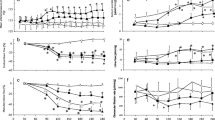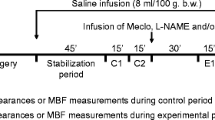Abstract
The balance of vascular tone between afferent (Af-) and efferent arterioles (Ef-Arts) is a crucial determinant of glomerular hemodynamics. Thus, to understand renal physiology and pathophysiology it is important to study the mechanisms that control their vascular resistance. In order to directly study these mechanisms, we have developed several in vitro microperfusion preparations of these arterioles, which have the advantage of allowing us to observe the arteriolar diameter directly in the absence of systemic hemodynamic and hormonal influences. Using these preparations, we have found that angiotensin II (Ang II) causes much stronger constriction in Ef- than in Af-Arts and that this difference is mediated by nitric oxide (NO)- and prostaglandin (PG)-induced modulation of Ang II action in the Af-Art. We have also found that the vasoconstrictor effect of Ang II on Ef-Arts is modulated by PG produced by the upstream glomerulus. Thus, this may be a mechanism whereby the glomerulus controls its own capillary pressure by releasing PG and thereby adjusting the resistance of the downstream Ef-Art. In addition, we have found that in these arterioles activation of the Ang II type 2 (AT2) receptor causes endothelium-dependent vasodilation, which modulates the vasoconstrictor action mediated by its type 1 (AT1) receptors. Such modulator mechanisms that regulate Af- and Ef-Art tone may play an important role in the precise control of glomerular hemodynamics, and their alterations may play a role in the pathophysiology of renal diseases, including hypertension. Indeed, we have demonstrated that the vasoconstrictor action of Ang II on the Af-Art is exaggerated in spontaneously hypertensive rats, an animal model of human essential hypertension, due to an impaired function of the AT2 receptor before the development of hypertension. Because such exaggerated vasoconstriction leads to the elevation of renal vascular resistance (an important pathogenic factor for essential hypertension), our findings suggest that impaired function of the AT2 receptor in Af-Arts may play a role in the pathophysiology of essential hypertension.
Similar content being viewed by others
Author information
Authors and Affiliations
Corresponding author
About this article
Cite this article
Arima, S. Role of angiotensin II and endogenous vasodilators in the control of glomerular hemodynamics. Clin Exp Nephrol 7, 172–178 (2003). https://doi.org/10.1007/s10157-003-0249-8
Received:
Accepted:
Issue Date:
DOI: https://doi.org/10.1007/s10157-003-0249-8




